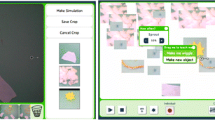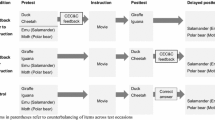Abstract
This study contrasted spontaneous and reflective knowledge integration instruction delivered using a computer learning environment to enhance understanding of displaced volume. Both forms of instruction provided animated experiments and required students to predict outcomes, observe results, and explain their ideas. In addition, the reflective instruction diagnosed specific inconsistencies in student reasoning and encouraged students to reflect on these dilemmas as well as to construct general principles. We distinguished the impact of instruction on students who believed scientific phenomena are governed by principles (cohesive beliefs) versus students who believed that science is a collection of unrelated “facts” (dissociated beliefs). Students typically held multiple models of displacement, using different explanations depending on the form of assessment. For example, we found that 17% of these middle school students made accurate predictions about displacement experiments prior to instruction and 25% could construct an accurate general principle. However, only 12% consistently used the same explanation across assessments. After instruction, students were more accurate and more consistent: over 50% accurately predicted experimental outcomes, 79% gave an accurate general principle, and about 40% gave consistent responses. We found no advantages for enhanced animations over straightforward animated experiments. The reflective integration instruction led to more substantial long-term changes in student understanding than did spontaneous integration instruction. Furthermore, on a delayed posttest we found that students with cohesive beliefs not only sustained their understanding of displaced volume, but, when exposed to reflective integration instruction, actually continued to construct more predictive views following instruction. In contrast, students with dissociated beliefs made no long-term progress independent of the form of instruction.
Similar content being viewed by others
REFERENCES
Anderson, J. R. (1976). Language, Memory, and Thought, Lawrence Erlbaum Associates, Hillsdale, NJ.
Bagno, E., and Eylon, B. S. (1997). From problem solving to a knowledge structure: An example from the domain of electromagnetism. The American Journal of Physics, 65: 726–736.
Bagno, E., Eylon, B. S., and Ganiel, U. (1993). Integrating domains of physics: Learning strategies and the role of teachers. In Novak (Ed.), Proceedings of the Cornell Conference.
Bell, P., and Linn, M. C. (in press). Scientific arguments as learning artifacts: Designing for learning from the Web with KIE. International Journal of Science Education.
Bereiter, C., and Scardamalia, M. (1986). The Psychology of Written Composition, Lawrence Erlbaum Associates, Hillsdale, NJ.
Bloom, B. S. (1984). The 2 sigma problem: The search for methods of group instruction as effective as one-to-one tutoring. Educational Researcher 13: 4–16.
Brown, J. S., Burton, R. R., and de Kleer, J. (1982). Pedagogical, natural language and knowledge engineering techniques in SOPHIE I, II and III. In Sleeman D., and Brown J. S. (Eds.), Intelligent Tutoring Systems, Academic Press, New York, pp. 227–282.
Burbules, N. C., and Linn, M. C. (1988). Response to contradiction: Scientific reasoning during adolescence. Journal of Educational Psychology 80: 67–75.
Carey, S., and Smith, C. (1993). On understanding the nature of scientific knowledge. Educational Psychologist 28: 235–251.
Davis, E. A. (1998). Scaffolding students' reflection for science learning. Unpublished doctoral dissertation, University of California at Berkeley, Berkeley.
Davis, E. A., and Linn, M. C. (in press). Scaffolding students' knowledge integration: Prompts for reflection in KIE. International Journal of Science Education.
diSessa, A. (1988). Knowledge in pieces. In Forman, G., and Pufall, P. (Eds.), Constructivism in the Computer Age. Lawrence Erlbaum Associates, Hillsdale, NJ, pp. 49–70.
Doyle, W. (1983). Academic work. Review of Educational Research 53: 159–199.
Eylon, B. S., and Linn, M. C. (1988). Learning and instruction: An examination of four research perspectives in science education. Review of Educational Research 58: 251–301.
Eylon, B. S., and Reif, R. (1984). Effects of knowledge organization on task performance. Cognition and Instruction 1: 5–44.
Friedler, Y., Nachmias, R., and Linn, M. C. (1990). Learning scientific reasoning skills in microcomputer-based laboratories. Journal of Research in Science Teaching 27: 173–191.
Gentner, D., and Stevens, A. L. (1983). Mental models. Lawrence Erlbaum Associates, Hillsdale, NJ.
Gordin, D., and Pea, R. D. (1995). Prospects for scientific visualization as an educational technology, Journal of the Learning Sciences 4: 249–279.
Grosslight, L., Unger, C., Jay, E., and Smith, C. (1991). Understanding models and their use in science: Conceptions of middle and high school students and experts. Journal of Research in Science Teaching 28: 799–822.
Johnson-Laird, P. N. (1983). Mental Models: Towards a Cognitive Science of Language, Inference, and Consciousness (Cognitive Science Series), Harvard University Press, Cambridge, MA.
Kuhn, D., Amsel, E., and O'Loughlin, M., with the assistance of Schauble, L. (1988). The Development of Scientific Thinking Skills (Developmental Psychology Series), Academic Press, Orlando, FL.
Larkin, J., McDermott, J., Simon, D. P., and Simon, H. A. (1980). Expert and novice performance in solving physics problems. Science 208: 1335–1342.
Lewis, E. L. (1991). The process of scientific knowledge acquisition among middle school students learning thermodynamics. Unpublished doctoral dissertation, University of California, Berkeley.
Lewis, E. L., and Linn, M. C. (1994). Heat energy and temperature concepts of adolescents, adults, and experts: Implications for curricular improvements. Journal of Research in Science Teaching 31: 657–677.
Linn, M. C. (1985). The cognitive consequences of programming instruction in classrooms. Educational Researcher 14: 14- 16, 25- 29.
Linn, M. C. (1986). Science. In Dillon, R., and Sternberg, R. J. (Eds.), Cognition and Instruction Academic Press, New York, pp. 155–204.
Linn, M. C. (1995). Designing computer learning environments for engineering and computer science: The scaffolded knowledge integration framework. Journal of Science Education and Technology 4: 103–126.
Linn, M. C. (in press). Designing Knowledge Integration Environment: The parnership inquiry process. International Journal of Science Education.
Linn, M. C., and Eylon, B.-S. (1996). Lifelong science learning: A longitudinal case study. In Proceedings of Cognitive Science Society, 1996, Lawrence Erlbaum Associates, Mahwah, NJ, pp. 597–602.
Linn, M. C., and Hsi, S. (2000). Computers, Teachers, Peers: Science Learning Partners. Lawrence Erlbaum Associates, Mahwah, NJ.
Linn, M. C., and Peterson, R. W. (1973). The effect of direct experience with objects on middle class, culturally diverse, and visually impaired young children. Journal of Research in Science Teaching 10: 83–90.
Linn, M. C., and Pulos, S. (1983). Male-female differences in predicting displaced volume: Strategy usage, aptitude relationships and experience influences. Journal of Educational Psychology 75: 86–96.
Linn, M. C., and Songer, N. B. (1991). Teaching thermodynamics to middle school students: What are appropriate cognitive demands? Journal of Research in Science Teaching 28: 885–918.
Linn, M. C., Songer, N. B., Lewis, E. L., and Stern, J. (1993). Using technology to teach thermodynamics: Achieving integrated understanding. In Ferguson, D. L. (Ed.), Advanced Educational Technologies for Mathematics and Science Vol. 107, Springer-Verlag, Berlin, pp. 5–60.
Linn, M. C., and Swiney, J. J. (1981). Individual differences in formal thought: Role of expectations and aptitudes. Journal of Educational Psychology 73: 274–286.
Piaget, J., and Inhelder, B. (1974). The Child's Construction of Quantities: Conservation and Atomism, Routledge & Kegan Paul, London.
Pulos, S., de Benedictis, T., Linn, M. C., Sullivan, P., and Clement, C. (1982). Modification of gender differences in the understanding of displaced volume. Journal of Early Adolescence 2: 61–74.
Reiser, B. J., Kimberg, D. Y. et al. (1992). Knowledge representation and explanation in GIL, an intelligent tutor for programming. In Larkin, J. H., and Chabay, R. W. (Eds.), Computer Assisted Instruction and Intelligent Tutoring Systems: Shared Goals and Complementary Approaches, Lawrence Erlbaum Associates, Hillsdale, NJ, pp. 111–149.
Ronen, M., and Eylon, B. (1993). To see or not to see: The eye in geometrical optics. Physics Education 28: 52–59.
Scardamalia, M., Bereiter, C., McLean, R., Swallow, J., and Woodrull, E. (1989). Computer supported intentional learning environments. Journal of Educational Computing Research 5: 51–68.
Schmidt, W. H., McKnight, C. C., and Raizen, S. A. (1997). A Splintered Vision: An Investigation of U.S. Science and Mathematics Education, Kluwer Academic Publishers, Dordrecht; Boston.
Slotta, J. D., and Chi, M. T. H. (1997). Instruction for conceptual change: The success story of ontology training. Paper presented at the Annual meeting of the American Educational Research Association, Chicago.
Slotta, J. D., and Linn, M. C. (in press). The knowledge integration environment: Helping students use the Internet effectively. In Jacobson, M. J., and Kozma, R. (Eds.), Learning the Sciences of the 21st Century. Lawrence Erlbaum Associates, Hillsdale, NJ.
Smith, C., Carey, S., and Wiser, M. (1985). On differentiation: A case study of development of the concepts of size, weight, and density. Cognition 21: 177–237.
Songer, N. B. (1993). Learning science with a child-focused resource: A case study of Kids as Global Scientists. Proceedings of the Fifteenth Annual Meeting of the Cognitive Science Society. Lawrence Erlbaum Associates, Hillsdale, NJ, pp. 935–940.
Songer, N. B. (1989). Promoting integration of instructed and natural world knowledge in thermodynamics. Unpublished doctoral dissertation, University of California, Berkeley.
Songer, N. B., and Linn, M. C. (1991). How do students' views of science influence knowledge integration? Journal of Research in Science Teaching 28,761–784.
White, B. Y. (1993). ThinkerTools: Causal models, conceptual change, and science education. Cognition and Instruction 10: 1–100.
Stratford, S. J., Krajcik, J., and Soloway, E. (1998). Secondary students' dynamic modeling processes: Analyzing reasoning about synthesizing, and testing models of stream ecosystems. Journal of Science Education and Technology 7: 215–233.
White, B. Y., and Frederiksen, J. R. (1998). Inquiry, modeling, and metacognition: Making science accessible to all students. Cognition and Instruction 16: 3–118.
Author information
Authors and Affiliations
Rights and permissions
About this article
Cite this article
Linn, M.C., Eylon, BS. Knowledge Integration and Displaced Volume. Journal of Science Education and Technology 9, 287–310 (2000). https://doi.org/10.1023/A:1009451808539
Issue Date:
DOI: https://doi.org/10.1023/A:1009451808539




